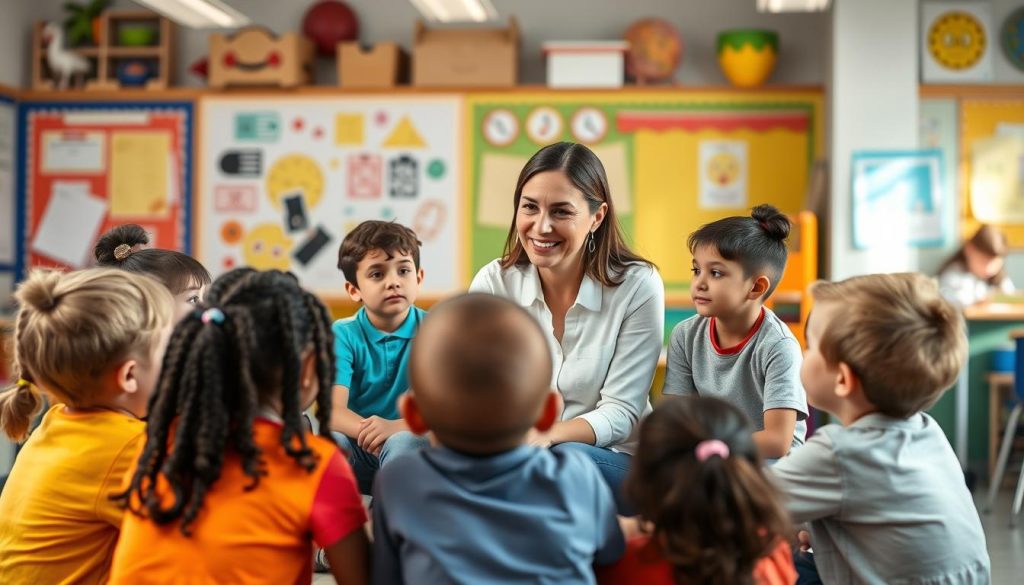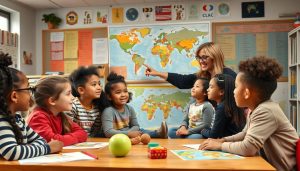Strategy 1: Active Listening Techniques for Better Understanding
Active listening is perhaps the most fundamental of all communication teacher skills. When teachers truly listen to their students, they validate feelings, build trust, and gain valuable insights into learning needs. This strategy goes beyond simply hearing words—it involves giving your full attention, showing empathy, and responding thoughtfully.
Key Components of Active Listening
- Maintain eye contact and open body language
- Avoid interrupting when students or parents are speaking
- Ask clarifying questions to ensure understanding
- Paraphrase what you’ve heard to confirm comprehension
- Acknowledge emotions being expressed
Professional development resources often emphasize that active listening is not just a passive skill but an active practice that requires conscious effort. When implemented consistently, this strategy helps teachers identify potential issues before they escalate and creates an environment where students feel valued and understood.
According to a study published by Edutopia, teachers who practice active listening report 40% fewer classroom management issues and significantly higher student engagement. These teacher skills translate directly to improved academic outcomes and a more positive classroom culture.
Pro Tip: Set aside dedicated time for one-on-one conversations with students. Even five minutes of focused listening can significantly strengthen your connection with a child and provide valuable insights into their learning needs.
Strategy 2: Clear Expectation-Setting Strategies
Establishing clear expectations is a crucial communication strategy that prevents misunderstandings and creates a structured learning environment. Effective teacher skills in this area involve not just stating rules but ensuring they’re understood, agreed upon, and consistently enforced.
Effective Ways to Communicate Expectations
- Create visual aids that outline classroom procedures
- Involve students in developing class norms
- Use consistent language when discussing expectations
- Provide written documentation for parents and students
- Revisit and reinforce expectations regularly
When communicating with parents about expectations, consistency is key. The Communicating with Parents and Families course offers excellent frameworks for ensuring your expectations are clearly understood by all stakeholders.
“The most effective teachers spend time at the beginning of the year establishing clear expectations and procedures, which significantly reduces behavioral issues and increases instructional time throughout the year.”
These expectation-setting teacher skills are particularly important during transitions—between activities, at the start of new units, or when introducing new classroom procedures. Clear communication during these times helps students feel secure and understand what success looks like.
Strategy 3: Digital Communication Strategies for the Modern Classroom
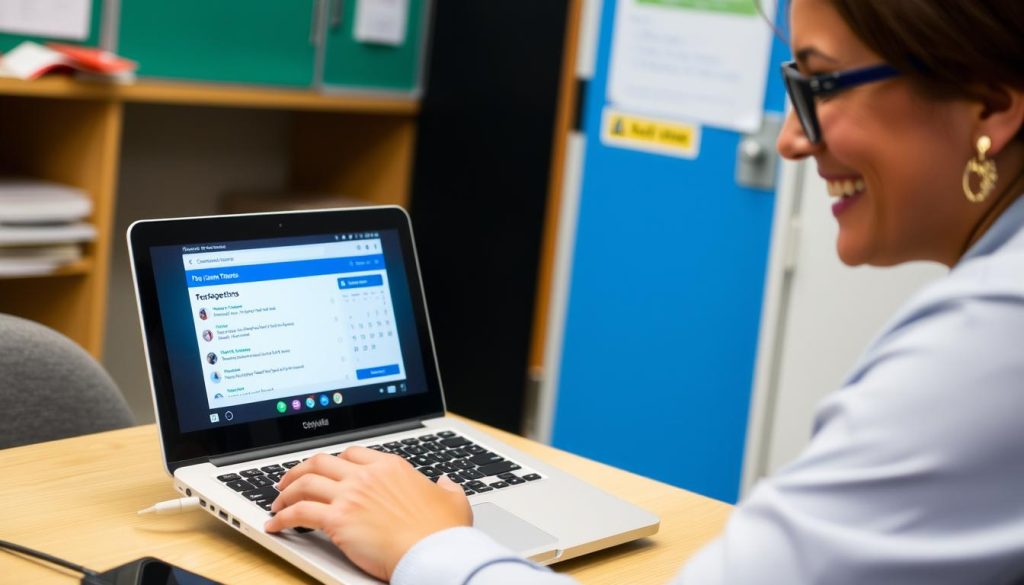
In today’s connected world, digital communication teacher skills have become essential. Leveraging technology allows for more frequent, efficient communication with both students and parents, creating a continuous feedback loop that supports learning.
Effective Digital Communication Tools
For Student Communication
- Learning management systems
- Digital discussion boards
- Video feedback on assignments
- Collaborative documents
For Parent Communication
- Weekly email newsletters
- Parent portal updates
- Digital progress reports
- Communication apps
When selecting digital tools, consider accessibility for all families. Not every household has equal access to technology or internet connectivity. Having alternative communication methods ensures you reach all parents effectively.
Developing these digital teacher skills may require additional training, but the investment pays off in improved communication efficiency. Professional development courses can help you master these tools while earning credits toward your continuing education requirements.
Important: Always follow your school’s policies regarding digital communication with students and parents. Maintain professional boundaries and ensure all communication is transparent and documented.
Strategy 4: Non-Verbal Communication Strategies That Enhance Teaching
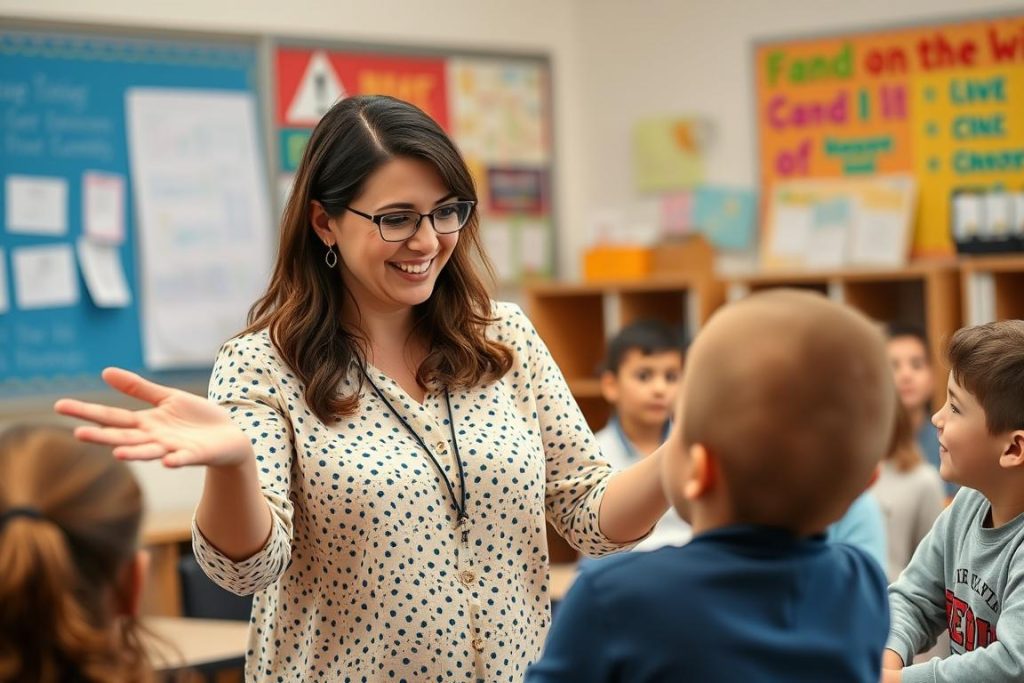
Research suggests that up to 93% of communication is non-verbal. For teachers, mastering non-verbal teacher skills can dramatically improve classroom management, student engagement, and overall teaching effectiveness.
Key Non-Verbal Communication Elements
- Facial expressions that convey interest and enthusiasm
- Body positioning that demonstrates accessibility
- Gestures that emphasize important concepts
- Proximity management to provide support or give space
- Voice modulation to maintain engagement
Being mindful of your non-verbal communication can be particularly important when working with students who have different cultural backgrounds or special needs. What might be interpreted as attentiveness in one culture could be seen as confrontational in another.
“The most powerful messages we send to students aren’t in what we say, but in how we say it and the non-verbal signals we provide.”
Developing these non-verbal teacher skills requires self-awareness and practice. Recording yourself teaching or asking for peer observation can provide valuable insights into your non-verbal communication patterns and areas for improvement.
The Communicating with Parents and Families course includes modules on non-verbal communication that can help you refine these crucial skills for both classroom and parent interactions.
Strategy 5: Conflict Resolution Strategies for Classroom Harmony
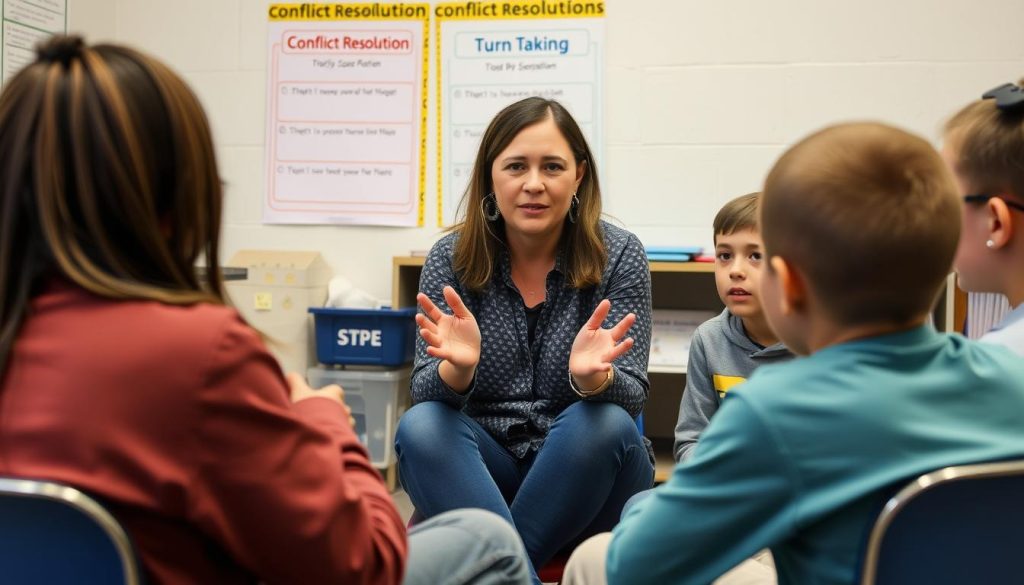
Conflict is inevitable in any classroom, but how teachers respond to it can transform challenges into valuable learning opportunities. Developing conflict resolution teacher skills allows you to maintain a positive learning environment while teaching students important life skills.
Effective Conflict Resolution Approach
- Remain calm and neutral when addressing conflicts
- Listen to all perspectives without judgment
- Help students identify the root cause of the conflict
- Guide students toward generating their own solutions
- Follow up to ensure the resolution is working
According to a study in the Journal of Moral Education, teachers who effectively model conflict resolution help students develop crucial social-emotional skills that extend far beyond the classroom.
These conflict resolution teacher skills are particularly important when communicating with parents about behavioral issues. Approaching these conversations with a solution-focused mindset rather than simply reporting problems creates a collaborative relationship with families.
Reflection Question: Think about a recent classroom conflict. How did you handle it? What communication strategies worked well, and what might you try differently next time?
Strategy 6: Culturally Responsive Communication Strategies
Elements of Culturally Responsive Communication
- Learn about the cultural backgrounds represented in your classroom
- Recognize different communication styles and preferences
- Use inclusive language and examples
- Acknowledge cultural holidays and celebrations
- Involve diverse family perspectives in classroom decisions
Culturally responsive teacher skills extend to parent communication as well. Understanding cultural norms around education, authority, and family involvement helps you build stronger partnerships with all families.
“Culturally responsive teaching is not just about acknowledging cultural differences—it’s about leveraging those differences as assets that enrich the learning experience for everyone.”
Developing these skills requires ongoing learning and self-reflection. Professional development resources can provide structured guidance for enhancing your culturally responsive communication practices.
Implementing These Communication Strategies in Your Classroom
Mastering these six communication strategies won’t happen overnight. Like any teacher skills, they require practice, reflection, and refinement. Here’s a practical approach to implementing these strategies in your classroom:
Start Small
Choose one strategy to focus on each week. For example, you might begin by practicing active listening during student conferences, then gradually incorporate other strategies as each becomes more natural.
Seek Feedback
Ask colleagues to observe your teaching and provide specific feedback on your communication. You might also survey older students or parents about the effectiveness of your communication approaches.
Reflect Regularly
Set aside time each week to reflect on your communication successes and challenges. Keeping a teaching journal can help you track your growth and identify patterns.
Continue Learning
Communication teacher skills evolve as education changes. Commit to ongoing professional development to stay current with best practices in educational communication.
Remember that different situations may call for different communication strategies. The key is developing a flexible toolkit of teacher skills that you can adapt to various classroom scenarios.
Conclusion: Building Your Communication Toolkit
Effective communication is at the heart of successful teaching. By intentionally developing these six communication strategies—active listening, clear expectation-setting, digital communication, non-verbal communication, conflict resolution, and culturally responsive communication—you’ll enhance your teacher skills and create a more positive, productive learning environment.
Remember that becoming an excellent communicator is a journey, not a destination. Even the most experienced teachers continue to refine their communication approaches throughout their careers. The investment you make in developing these teacher skills will pay dividends in student engagement, parent partnerships, and your own professional satisfaction.
Take Your Communication Skills to the Next Level
Ready to deepen your expertise in educational communication? The Communicating with Parents and Families course offers comprehensive strategies, practical templates, and expert guidance to help you build stronger school-home partnerships.
Frequently Asked Questions About Communication Strategies for Teachers
How can I improve communication with parents who seem disengaged?
Start by examining your current communication methods and consider whether they’re accessible to all families. Some parents may face barriers like language differences, work schedules, or technology access. Try multiple communication channels, focus on positive news (not just problems), and make interactions convenient. The key teacher skills here involve persistence and flexibility in your approach.
What’s the best way to handle difficult conversations with parents?
Prepare thoroughly, begin with positive observations about their child, use specific examples rather than generalizations, listen actively to parent perspectives, and focus on collaborative solutions. These communication teacher skills help maintain a partnership approach even in challenging situations. The Communicating with Parents and Families course offers detailed frameworks for navigating these conversations effectively.
How often should I communicate with parents?
The frequency depends on grade level, school policies, and individual student needs. Generally, a weekly or bi-weekly class update combined with individual communications as needed strikes a good balance. The most important teacher skills here involve consistency and relevance—regular, meaningful communication builds stronger partnerships than frequent but superficial updates.

